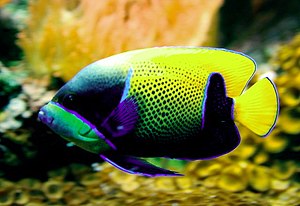Blue belt angelfish
| Blue belt angelfish | ||||||||||||
|---|---|---|---|---|---|---|---|---|---|---|---|---|

Blue belt angelfish ( Pomacanthus navarchus ) |
||||||||||||
| Systematics | ||||||||||||
|
||||||||||||
| Scientific name | ||||||||||||
| Pomacanthus navarchus | ||||||||||||
| ( Cuvier , 1831) |
The Blue Belt Angelfish ( Pomacanthus navarchus , Syn. : Euxipiphops navarchus ) or dream Angelfish is a kind from the family of angelfish (Pomacanthidae). It occurs in the coral reefs of the central Indo-Pacific from Indonesia and the Philippines to New Guinea , Palau , the Yap Islands , the Rowley Shoals and the Great Barrier Reefin front. Blue belt angelfish live on reef slopes or lagoons at depths of 2 to 40 meters.
features
Blue-belted angelfish grow up to 28 centimeters long. The fry are similar to those of other angelfish from the genus Pomacanthus . They are dark blue, almost black, and show a pattern of light blue vertical stripes. They can be distinguished from the juvenile fish of other Pomacanthus species by their orange dorsal fin and transparent caudal fin . When they have reached a length of five to eight centimeters, they change color. The color change must be done very quickly, fish in transitional colors have only been seen very rarely.
Adult dream angelfish have bright yellow and blue patterns. The flanks, dorsal fin, caudal fin and throat are yellow, with the flanks being dotted blue. The paired fins, the anal fin, the snout, the top of the head and the rear trunk area with the caudal fin stalk are dark blue. All fins have light blue edges.
Fin formula : Dorsal XIII – XIV / 17–18, Anale III / 18.
Way of life
Blue belt angelfish live individually or in pairs. Rivals are chased away by grunts. They feed on sponges , sea squirts and algae. Their eggs and larvae are pelagic . Young fish pass over to life in the coral reef at a length of two centimeters.
Aquarium keeping
Blue belt angelfish are occasionally imported for keeping in saltwater aquariums. However, the fish, which grow very large for home aquariums, cannot be offered a species-appropriate, natural environment, as the territorial requirements of most species are simply far too large. In large public show aquariums, the blue-belt angelfish is already 26 years old.
literature
- Frank Schneidewind: Angelfish . 1999, Tetra Verlag, ISBN 3-89745-137-9
- Roger C. Steene: Butterfly and Angelfish. Volume 1, 1979, Mergus Verlag, ISBN 3-88244-001-5
- Hans A. Baensch / Robert A. Patzner: Mergus Sea Water Atlas Volume 6. Mergus-Verlag, Melle, ISBN 3-88244-116-X
Web links
- Blue Belt Angelfish on Fishbase.org (English)
- Pomacanthus navarchus inthe IUCN 2013 Red List of Threatened Species . Listed by: Pyle, R., Rocha, LA & Craig, MT, 2010. Retrieved September 30, 2013.